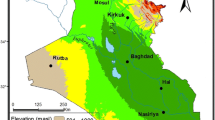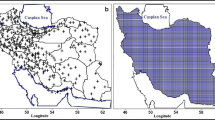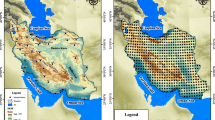Abstract
The present study intends to show the effect of climate change on trends and patterns of temperature over the southwestern part of Iran. The research has been divided into two parts. The first part consists of an analysis of the temperature trends of mean temperature (TM), maximum temperature (TMAX), and minimum temperature (TMIN) over 39 stations in the study region for the period 1950–2007. The trends in these parameters were detected by linear regression, and significance was tested by t test. Mann–Kendall rank test (MK test) was also employed to confirm the results. The second part of the research involved future projection of temperature based on four models. The models used were Centre National de Recherches Meteorologiques, European Center Hamburg Model, Model for Interdisciplinary Research on Climate, and UK Meteorological Office. Temperature projections were done under B1 and A1B emissions scenarios. The analysis of temperature trends revealed a significant increase during summer and spring seasons. TMAX was stable than TMIN and TM, and winter was stable as compared with summer, spring, and autumn seasons. Results of modeling showed that temperature may increase between 1.69 and 6.88 °C by 2100 in the study area. Summer temperatures may increase with higher rates than spring, winter, and autumn temperatures.












Similar content being viewed by others
References
Al Buhairi MH (2010) Analysis of monthly, seasonal and annual air temperature variability and trends in Taiz City-Republic of Yemen. J Environ Prot 1(4):401–409. doi:10.4236/jep.2010.14046
Alexandersson HA (1986) A homogeneity test applied to precipitation data. Int J Climatol 6:661–675. doi:10.1002/joc.3370060607
Alexandersson H, Moberg A (1997) Homogenization of Swedish temperature data. Part I: homogeneity test for linear trends. Int J Climatol 17:25–34. doi:10.1002/(SICI)1097-0088(199701)17:1<25::AID-JOC103>3.0.CO;2-J
Alijani B (1997) Some statistical characteristics of temperature variations in Iran. J Res in Geogr 31:24–33
Azizi GH, Rowshano M (2008) Studying the climate change in the Southern coasts of the Caspian Sea based on Mann–Kendal method. Geogr Stud 64:13–28 (in Persian)
Babaeian I, Najafi-Nik Z, Zabol Abbassi F, Habibi Nokhandan M, Adab H, Malbousi S (2010) Climate change assessment over Iran during 2010–2039 by using statistical downscaling of ECHO-G model. J Geogr Dev 16:136–152 (in Persian)
Da Silva Vde P, de Azevedo PV, Brito RS, Campos JH (2010) Evaluating the urban climate of a typically tropical city of northeastern Brazil. J Environ Monit Assess 161(1–4):45–59
Dhorde A, Wakhare A (2009) Evidence of long-term climate change at major cities of India during the twentieth century. Int J Clim Change Imp Res 1:15–41
Dhorde A, Dhorde A, Gadgil A (2009) Long-term temperature trends at four largest cities of India during the twentieth century. J Ind Geophys Union 13(2):85–97
Gadgil A, Dhorde A (2005) Temperature trends in twenties century at Pune, India. J Atmos Environ 39:6550–6556
Ghahraman B (2006) Time trend in the mean annual temperature of Iran. Turk J Agric For 30:439–448
IPCC (2007) Summary for policymakers. In: Solomon S, Qin D, Manning M, Chen Z, Marquis M, Averyt KB, Tignor M, Miller HL (eds) Climate change 2007: the physical science basis. Contribution of Working Group I to the Fourth Assessment Report of the Intergovernmental Panel on Climate Change. Cambridge University Press, Cambridge
Iran Department of Environment (2009) The Islamic Republic of Iran Internal Conference on climate change. J Nyvar 57:45–55, Abstract (in Persian)
Jones C, Gregory J, Thorpe R, Cox P, Murphy J, Sexton D, Valdes H (2004) Systematic optimization and climate simulation of FAMOUS, a fast version of HADCM3. Hadley Centre Technical Note 60, 33 pp. Available from http://www.metoffice.gov.uk/research/hadleycentre/pubs/HCTN/HCTN_60.pdf
Jungclaus JH, Keenlyside N, Botzet M, Haak H, Luo JJ, Latif M, Marotzke J, Mikolajewicz U, Roeckner E (2006) Ocean circulation and tropical variability in the coupled model ECHAM5 = MPI-OM. J Climate 19:3952–3972
K-1 Model Developers (2004) K-1 Coupled GCM (MIROC) description. In: Hasumi H, Emori S (eds) K-1 Tech Report No. 1, Center for Climate System Research,University of Tokyo, National Institute for Environmental Studies, Frontier Research Center for Global Change, 39 pp. Available at http://www.ccsr.u-tokyo.ac.jp/kyosei/hasumi/MIROC/tech-repo.pdf
Karaburun A, Demirci A, Kara F (2011) Analysis of spatially distributed annual, seasonal and monthly temperatures in Istanbul from 1975 to 2006. J World Appl Sci 12(10):1662–1675
Karl TR, Trenberth KE (2003) Modern global climate change. J Sci 302:1719–1723
Koo GS, Boo KO, Kwon WT (2009) Projection of temperature over Korea using an MM5 regional climate simulation. J Climate Res 40:241–248. doi:10.3354/cr00825
Kothawale DR, Pupa KK (2006) On the Recent change in surface temperature trends over India. J Geophys Res Lett 32: L18714 4 pp. doi:10.1029/2005GL023528
Kousari MR, Ekhtesasi MR, Tazeh M, Naeini MA, Zareh MA (2011) An investigation of the Iranian climatic changes by considering the precipitation, temperature, and relative humidity parameters. Theor Appl Climatol 103:321–335
Kripalani RH, Oh JH, Kulkarni A, Sabade SS, Chaudhari HS (2007) South Asian summer monsoon precipitation variability: coupled climate model simulations and projections under IPCC AR4. Theor Appl Climatol 90:133–159
Liu L, Hong Y et al (2011) Analyzing projected changes and trends of temperature and precipitation in the southern USA from 16 downscaled global climate models. Theor Appl Climatol 109:345–360. doi:10.1007/s00704-011-0567-9
Partal T, Kahya E (2006) Trend analysis in Turkish precipitation data. Hydrol Process 20:2011–2026
Pettitt AN (1979) A non-parametric approach to the change point problem. J Appl Statist 28(2):126–135
Pielke Sr RA, Davey CA et al (2007) Unresolved issues with the assessment of multidecadal global land surface temperature trends. J Geophys Res 112:D24S08. doi:10.1029/2006JD008229
Prcntice LC, Farquhar M et al (2001) Climate change 2001: the scientific basis. Contribution of Working Group I to the, Third Assessment Report of the Intergovernmental Panel on Climate Change. Cambridge University Press, Cambridge
Roshan GH, Khoshakh LF, Azizi GH, Mohammadi H (2011) Simulation of temperature changes in Iran under the atmosphere carbon dioxide duplication condition. Iran J Environ Health Sci Eng 8:139–152
Sabade SS, Kulkarni A, Kripalani RH (2010) Projected changes in South Asian summer monsoon by multi-model global warming experiments. Theor Appl Climatol 103:543–565. doi:10.1007/s00704-010-0296-5
Sabohi R, Soltani S (2009) Trend analysis of climatic factors in great cities of Iran. J Sci Technol Agric Nat Res Water Soil Sci 12(46):303–321
Salas MD, Chauvin F, Deque M, Douville H, Gueremy JF, Marquet P, Planton S, Royer JF, Tyteca S (2006) Description and validation of the CNRM-CM3 global coupled model. CNRM Tech. Rep. 103
Shifteh Some′e B, Ezani A, Tabari H (2012) Spatiotemporal trends and change point of precipitation in Iran. Atmos Res 113:1–12
Smadi MM (2006) Observed abrupt changes in minimum and maximum temperatures in Jordan in the 20th century. Am J Environ Sci 2(3):114–120. doi:10.3844/ajessp.2006.11.4.120
Soltani E, Soltani A (2008) Climatic change of Khorasan, North-East of Iran, during 1950–2004. Res J Environ Sci 2(5):316–322. doi:10.3923/rjes.2008.316.322
Tabari H, Hosseinzadeh Talaee P (2011a) Recent trends of mean maximum and minimum air temperatures in the western half of Iran. Meteor Atmos Phys 111:121–131
Tabari H, Hosseinzadeh Talaee P (2011b) Analysis of trends in temperature data in arid and semi arid-regions of Iran. J Global Planet Change 79:1–10
Tabari H, Marofi S (2011) Changes of pan evaporation in the west of Iran. Wat Res Manag 25:97–111
Tabari H, Shifteh SB, Rezaeian ZM (2011a) Testing for long-term trends in climatic variables in Iran. Atmos Res 100:132–140
Tabari H, Hosseinzadeh TP, Ezani A, Shifteh Some’e B (2011b) Shift changes and monotonic trends in autocorrelated temperature series over Iran. Theor Appl Climatol 109:95–108
Tabari H, Marofi S, Aeini A, Hosseinzadeh TP, Mohammad K (2011c) Trend analysis of reference evaptranspiration in western half of Iran. J Agric For Meteorol 151:128–136
Tayanç M, Im U, Dogruel M, Karaca M (2009) Climate change in Turkey for the last half century. J Climatic Change 94:483–502
Tecer LH (2009) Temperature trends and changes in Rize, Turkey for the period 1975 to 2007. J Clean Soil Air Water 37(2):150–159. doi:10.1002/clen.200800021
Tomozeiu R, Cacciamani C, Pavan V, Morgillo A, Busuioc A (2007) Climate change scenarios for surface temperature in Emilia-Romagna (Italy) obtained using statistical downscaling models. Theor Appl Climatol 90:25–47. doi:10.1007/s00704-006-0275-z
von Storch H (1995) Misuses of statistical analysis in climate research. In: Storch HV, Navarra A (eds) Analysis of climate variability: applications of statistical techniques. Springer, Berlin, pp 11–26
Zhang XC, Liu WZ, Li Z, Chen J (2011) Trend and uncertainty analysis of simulated climate change impacts with multiple GCMs and emission scenarios. J Agr Forest Meteorol 151(10):1297–1304. doi:10.1016/j.agrformet.2011.05.010
Acknowledgments
The authors are thankful to the IRIMO and Water Resources Management Organization of the Ministry of Energy Islamic Republic of Iran for providing observed data. We also acknowledge the modeling groups for providing their data for analysis, the PCMDI, Lawrence Livermore National Laboratory, USA for collecting and archiving the model output and for providing necessary data required for the study. The authors also thank the anonymous reviewers for their comments and suggestions which helped in improving the quality of the manuscript.
Author information
Authors and Affiliations
Corresponding author
Rights and permissions
About this article
Cite this article
Zarenistanak, M., Dhorde, A.G. & Kripalani, R.H. Temperature analysis over southwest Iran: trends and projections. Theor Appl Climatol 116, 103–117 (2014). https://doi.org/10.1007/s00704-013-0913-1
Received:
Accepted:
Published:
Issue Date:
DOI: https://doi.org/10.1007/s00704-013-0913-1




